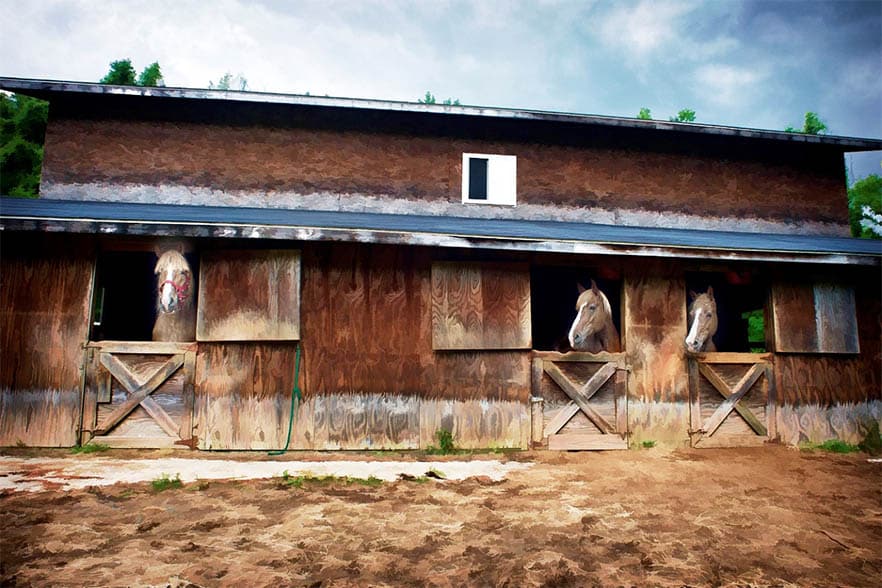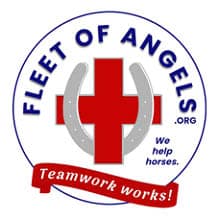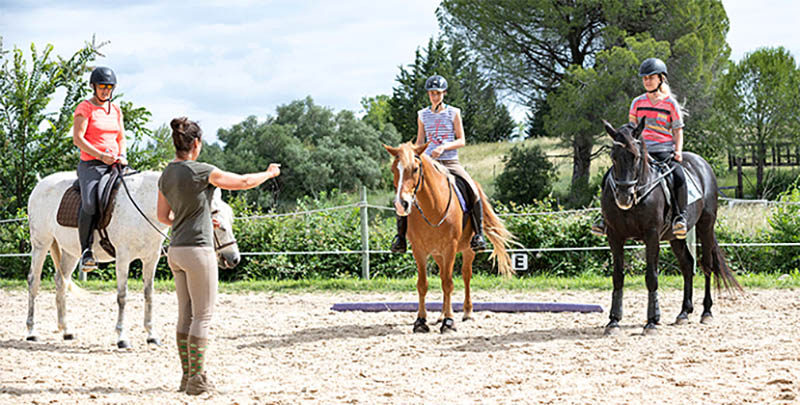Fire, wind, rain, and snow can cause major damage to a horse barn rendering it unusable. Despite taking every type of precaution to save a structure from destruction, the forces of nature are sometimes too powerful for any building, no matter how well constructed, to withstand.
There are many resources available online that address disaster preparedness for horse owners and recovery procedures following a calamity such as a hurricane, tornado, or fire. Check out salient advice from the folks at Texas A &M Agrilife Extension on methods to decontaminate pastures and property after flooding, clear debris and dead animal carcasses and Colorado State University Extension guidelines for wildfire preparedness.
When a region is hit by a major event such as a massive fire burning out of control or a tornado rips through a neighborhood, emergency services are activated along with lots of press coverage and helping hands. This invaluable aid often orchestrated by the government helps displaced residents and their animals find shelter elsewhere.
But many cases of catastrophic damage to the horse barn are not caused by hazardous weather events that impact a large geographical region. In the case of a barn fire or barn roof collapse there are minimal resources on hand to address issues such as temporary horse housing needed or people on hand offering to help. The horse owner is left to navigate the road to recovery alone.
Here are a few tips to help guide the property owner through the process.
Immediate Needs First
While the insurance company (hopefully the structure was insured), will send their insurance adjuster out to the site to liaise with the relevant authorities such as fire investigators or local building inspectors, the horses that were on site will need a safe haven where their well-being and medical needs can be addressed.
In most cases the horses won’t require the high level of medical attention and care that a veterinary hospital provides but will need some professional care and management. Just like humans, animals can suffer from post-traumatic stress disorder {PTSD} following a painful or scary event. Equines suffering from this condition may display colic, aggression or erratic mood changes and their immune system may be compromised due to the stress.
It is important that horses that are moved from their home location are monitored closely for any signs of health issues following a catastrophic event. Smoke inhalation, lameness issues or eye injuries along with PTSD are not always obvious at first glance. For this reason, wherever the horses find a soft landing, it is prudent to try and keep a weather eye on them hopefully by those that know them best.
The horse community is full of people willing to lend a hand in case of emergency needs, but they have to know there is a need to respond. Without the media coverage a major disaster generates the only way to spread word of your need is to take it upon yourself. Professional equestrian colleagues and horsey friends, your soft circle, is a great place to ask for help. Social media is a good way to spread the word of the catastrophic event and to seek locations for stabling needs. Social media platforms are also a logical place to request help funding your horses’ care needs if that is necessary.
If the barn was utilized and insured as a business operation, then loss of business clauses in farm insurance policies will often help defray expenses and loss of revenue, but there will likely be many areas of expense that are not going to be reimbursed or replaced by the insurance carrier. Don’t be shy to ask for help, regardless of whether it is a private use barn or a commercial facility.
Local community resources such as fairgrounds, may also have stabling available for rent or use, but some form of on-site presence or security will be needed. An RV rental may be an option as many fairgrounds offer RV hook up options.
It may be necessary to temporarily disperse your horse herd to various locations in order to find them accommodation. Whatever means you are able to manage the immediate need to remove the horses from the property for their safety, it’ll be a short step to part two in the process, figuring out how to bring them home.
Temporary Housing Solutions
Sadly, barn fires are common, and no-one is immune to the chance of it happening or the catastrophic effects such an occurrence has on their lives. Olympic eventer Boyd Martin and his wife Silva experienced a major barn fire at their beautiful property Windurra USA back in 2011, and in their case temporary stalls were found via the leading modular horse barn company Horizon Structures, to service their horses’ needs. A modular barn builder is a good place to source stabling especially when there is an immediate need for replacement.
Temporary horse stabling in the form of secondhand stalls, rented show stalls, or used modular stabling are a good solution for horse housing needs, and can allow horses to be brought home quickly once the site itself has been cleared of debris, contaminants and is safe for use. Stalls can be set up in indoor arenas or inside fenced paddocks or outdoor arenas on a temporary basis.
Horse trailers can also serve as a form of shelter within a paddock, though care must be taken to protect the equipment from damage from the horses to its wires/lights and exterior and to limit the risk of injury to the horses themselves.
Run-in sheds also provide a good form of shelter and can be quickly purchased online from in stock sales lots and delivered and set up ready for immediate use.
Run-in sheds may be placed almost anywhere on a property, even areas with poor access, via the use of a ‘mule’ – a machine that can transport the shed from the delivery truck across variant terrain to place it on site. Placement of run-in sheds in paddocks and pastures is a flexible option, as run-in sheds designed with tow hooks can easily be moved around later to a different location once a new barn is built.
More permanent stabling, in the form of shed row designs and 2-stall barns are also available to purchase off the lot at larger modular building companies. Along with financing options and ‘to the penny’ pricing the modular structure offers a great means to get the horses home and secure their housing quickly.
Build Back Fast
Buying a horse barn online from a modular barn construction company that has proven fine reputation and offers a myriad of options for design and customizations can expedite the barn build back process.
Unaffected by weather delays, material shortages and with a known cost basis, the modular barn building company offers a reliable product and timeline for completion as well as total cost. Don’t let your build back decision be limited by what is advertised down the road or in the local neighborhood. Modular barn builds are available from companies with a national footprint, so your location no longer needs to limit access to good craftsmanship and budget options in a variety of horse barn styles and designs.
Many of the services needed for the barn such as water and electric, are already in place at the building site and once the damaged building is demolished and removed and the area cleared it is usually very straightforward to reuse the likely already level site and refresh services.
Have A Positive Attitude
Losing your horse barn to a fire, flood, wind, or snow damage is a traumatic event and it will take time to recover from the experience both emotionally and financially.
The only way to manage the recovery is to take it one day at a time. Along the road to full recovery, you will most likely encounter many good-hearted people that will go out of their way to help you rebuild.
When rebuilding is possible, take the opportunity to build it back better, update it, retune your needs or redefine the complexion of your landscape. Construction methods and materials, style and design of horse barns have all changed considerably over time. While you will understandably be in a rush to have the new horse barn constructed, remember to still do your due diligence, and buy a barn based on good business sense.
For example, the cheapest option is not always the best option. Buy the best quality product you can afford and be certain that you have a clearly written, detailed quotation and do not part with any money without an executed contract.
Look for a company that stands behind its work, offers warranties that you can read now, and provides a ‘to the penny’ quote without open ended statements where they can opt out of an amount quoted for the job. Many larger construction companies will also offer financing options which can be a good way to get you back on your feet.
When you collaborate with a customer service team that exhibits the empathy and knowledge to help you manage the financial constraints and provide a positive purchasing process the eventual outcome from the negative experience can become a positive one. Keep putting your best foot forward. You’ll get there!


















